Birdfinding.info ⇒ The Hawaiian form of Short-eared Owl, known as the Pueo, is locally common on the main Hawaiian Islands—except Oahu, where it is rare. Consistent sites include: on Kauai, Waimea Canyon and the Kaumualii Highway; on Maui, Haleakala National Park and the Haleakala Highway; and on the Big Island, Waiki’i Ranch and Saddle Road.
“Hawaiian Short-eared Owl”
Asio flammeus sandwichensis
Endemic to Hawaii, where it is resident on all eight of the major islands from Niihau to the Big Island, where it occurs in all open habitats with sufficient ground cover for roosting.
Identification
Apparently indistinguishable from the widespread “Northern Short-eared Owl”. Unique in its limited range, except for the likely unnoticed arrivals of vagrant “Northerns”.
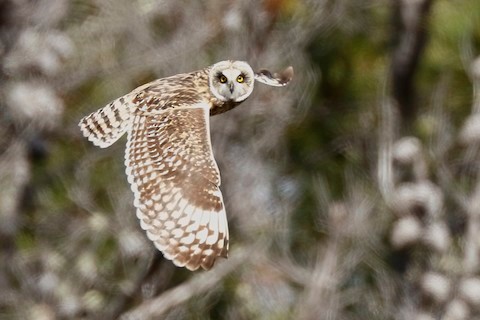
“Hawaiian Short-eared Owl,” A. f. sandwichensis, a relatively pale-brown individual in flight. (Hosmer Grove, Haleakala National Park, Maui, Hawaii; October 15, 2017.) © Sharif Uddin
An open-country owl that often hunts on the wing, flying low over grasslands and marshes, with a meandering, harrier-like flight pattern that alternates between deep, floppy wingbeats and long glides. It also hunts while stationary, perched on top of a bush or fencepost, watching and waiting, then swooping down onto its prey. Largely diurnal, but also active at night and most active around dusk.
Short-eared Owls are named for an inconspicuous feature: two short tufts on the crown that are sometimes raised but often lie flat.
The plumage is mainly dark-brown and whitish. The upperparts are mostly dark-brown with pale spots; and the underparts are mostly whitish with dark-brown streaks.

“Hawaiian Short-eared Owl,” A. f. sandwichensis, a relatively dark-brown individual showing short ear-tufts on the crown partly raised. (Saddle Road, Big Island, Hawaii; January 1, 2020.) © David McQuade
The streaking on the underparts is dense and thick on the chest, becoming progressively sparser on the lower breast and belly.
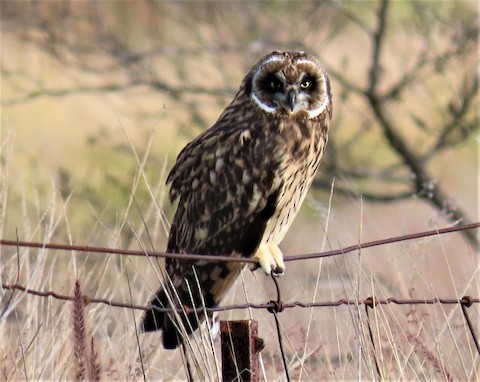
“Hawaiian Short-eared Owl,” A. f. sandwichensis, a relatively dark individual with a distinct white-framed facial disk. (Saddle Road, Big Island, Hawaii; March 25, 2019.) © Jan Thom
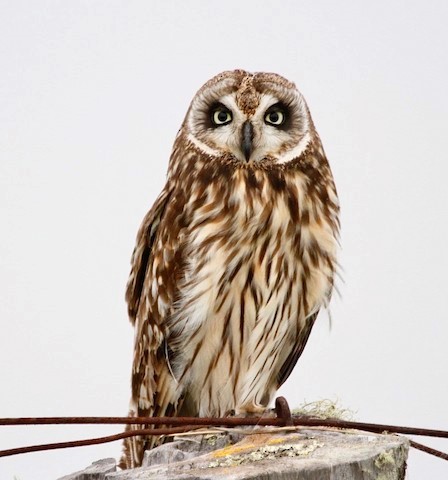
“Hawaiian Short-eared Owl,” A. f. sandwichensis, showing typical underparts pattern: heavy streaking on the chest that becomes progressively sparser on the belly. (Waiki’i Ranch, Big Island, Hawaii; April 12, 2020.) © Sherman Wing
Sometimes shows a distinct facial disk and sometimes not. Some individuals show a distinct contrasting white frame, some have a thin blackish frame, and some have no discernible frame. The eyes are vivid amber-yellow surrounded by black feathers.
In flight, the upperside of the wing appears mostly brown with large buffy patch in the primaries.
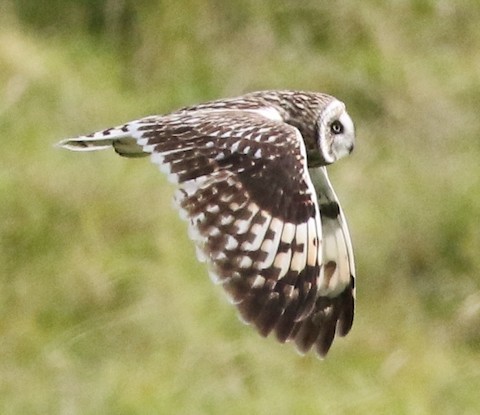
“Hawaiian Short-eared Owl,” A. f. sandwichensis, dorsal view in flight, showing mostly brownish upperwings with buffy windows in the primaries. (Saddle Road, Big Island, Hawaii; November 17, 2019.) © Patrick Vaughan
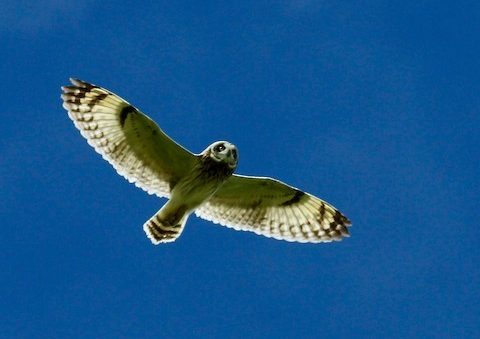
“Hawaiian Short-eared Owl,” A. f. sandwichensis, ventral view in flight, showing mostly pale underwings with dark-brown crescents on the primaries. (Waiki’i Ranch, Big Island, Hawaii; February 26, 2014.) © Doug Cooper
The underside of the wing is mostly pale with a prominent black crescent at the base of the primaries. Typically shows one or two additional dark crescents near the tips of the primaries.
Voice. The “Hawaiian Short-eared Owl” is not known to be vocally distinct from the “Northern” form, whose vocalizations are provided here.
The male’s mating or territorial call is a series of series of 8-20 quick, hollow hoots: Sometimes the hoots are higher-pitched:Rapid bouts of wing-clapping are often heard:Contact calls include a hoarse, nasal bark or yip with a rising inflection and sudden stop:Sometimes calls in bouts of 2-10 barks that resemble the scolding of a jay:Or soft, low growls given in quick series:Alarm calls include harsh, catlike growls and screeches:
Notes
Monotypic form, one of three or four potentially distinct forms of Short-eared Owl. The “Hawaiian Short-eared Owl” does not appear to be genetically isolated from the “Northern Short-eared Owl” (A. f. flammeus), as the latter regularly occurs as a winter visitor in parts of the Hawaiian Islands—certainly in the Northwest Chain, but almost certainly in the main islands as well. Considering that the two appear to be indistinguishable it may be inappropriate to regard sandwichensis as a distinct form.
Locally known by its traditional Hawaiian name: “Pueo.”
More Images of the “Hawaiian Short-eared Owl”
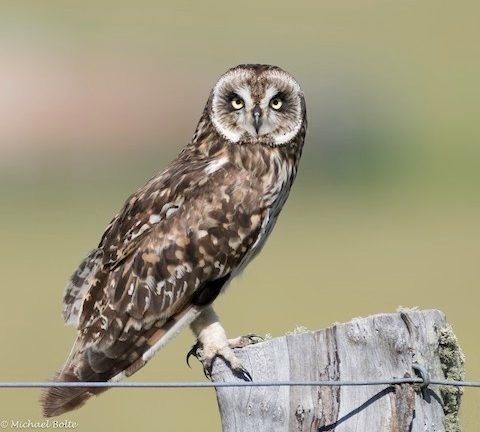
“Hawaiian Short-eared Owl,” A. f. sandwichensis. (Waiki’i Ranch, Big Island, Hawaii; August 28, 2017.) © Michael Bolte
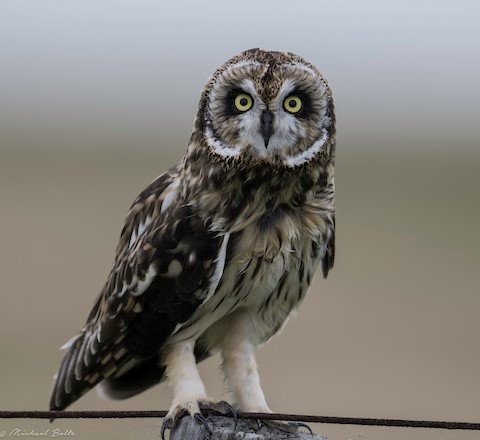
“Hawaiian Short-eared Owl,” A. f. sandwichensis. (Old Saddle Road, Big Island, Hawaii; September 3, 2019.) © Michael Bolte
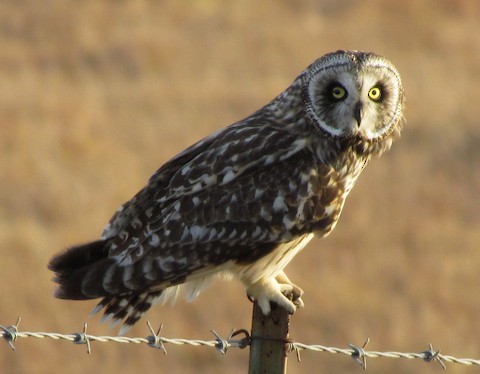
“Hawaiian Short-eared Owl,” A. f. sandwichensis. (Hawaii Belt Road, Big Island, Hawaii; May 19, 2015.) © Darren Dowell

“Hawaiian Short-eared Owl,” A. f. sandwichensis. (Waiki’i Ranch, Big Island, Hawaii; March 28, 2018.) © Bill Lisowsky
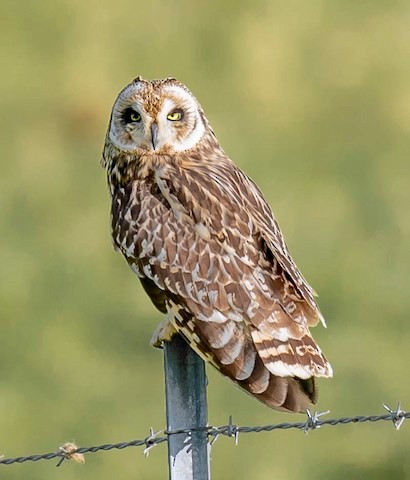
“Hawaiian Short-eared Owl,” A. f. sandwichensis. (Waiki’i Ranch, Big Island, Hawaii; December 4, 2019.) © William Richards

“Hawaiian Short-eared Owl,” A. f. sandwichensis. (Waiki’i, Big Island, Hawaii; January 23, 2020.) © Christopher Escott
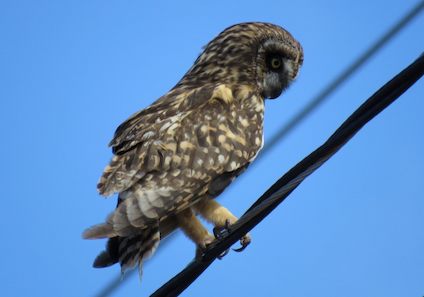
“Hawaiian Short-eared Owl,” A. f. sandwichensis. (Kawaiele State Waterbird Sanctuary, Kauai, Hawaii; September 22, 2017.) © Patrick Baglee
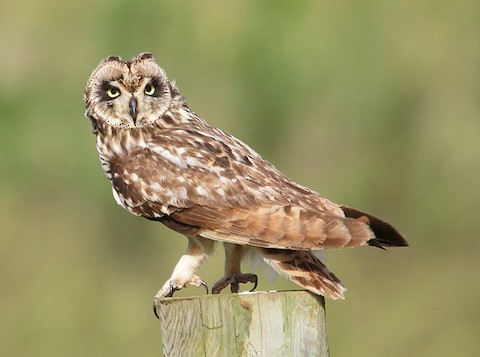
“Hawaiian Short-eared Owl,” A. f. sandwichensis. (Miki Road, Lanai, Hawaii; April 20, 2006.) © Michael Walther
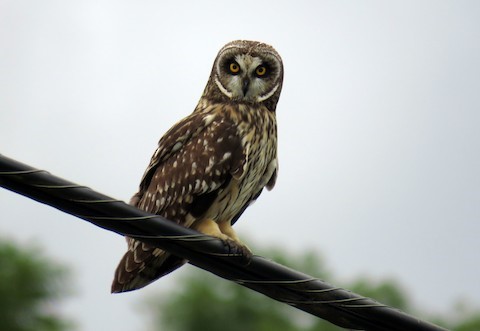
“Hawaiian Short-eared Owl,” A. f. sandwichensis. (Maui, Hawaii; February 25, 2017.) © Mark Salvidge
“Hawaiian Short-eared Owl,” A. f. sandwichensis. (Waimea Canyon, Kauai, Hawaii; March 20, 2019.) © Barry Langdon-Lassagne
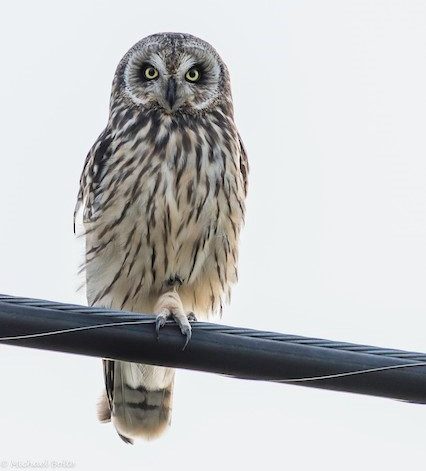
“Hawaiian Short-eared Owl,” A. f. sandwichensis. (Waiki’i Ranch, Big Island, Hawaii; August 28, 2017.) © Michael Bolte

“Hawaiian Short-eared Owl,” A. f. sandwichensis. (Saddle Road, Big Island, Hawaii; April 27, 2019.) © Lizabeth Southworth
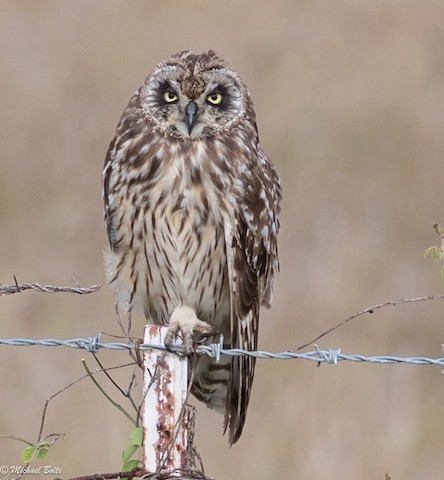
“Hawaiian Short-eared Owl,” A. f. sandwichensis. (Saddle Road, Big Island, Hawaii; June 5, 2016.) © Michael Bolte

“Hawaiian Short-eared Owl,” A. f. sandwichensis. (Old Saddle Road, Big Island, Hawaii; September 3, 2019.) © Michael Bolte
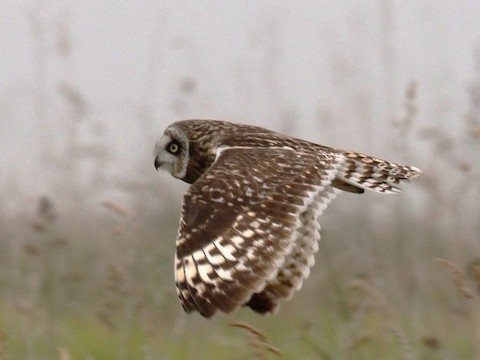
“Hawaiian Short-eared Owl,” A. f. sandwichensis. (Saddle Road, Big Island, Hawaii; January 21, 2020.) © Richard Pollard
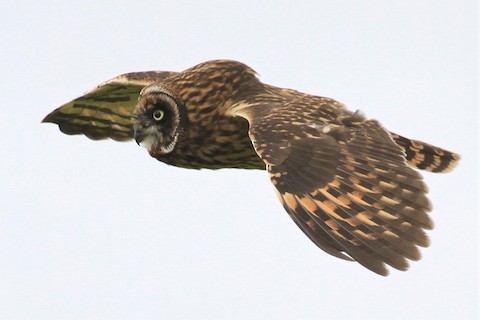
“Hawaiian Short-eared Owl,” A. f. sandwichensis. (Waiki’i Ranch, Big Island, Hawaii; February 5, 2020.) © Kent Forward

“Hawaiian Short-eared Owl,” A. f. sandwichensis. (Saddle Road, Big Island, Hawaii; April 27, 2019.) © Lizabeth Southworth

“Hawaiian Short-eared Owl,” A. f. sandwichensis. (Hosmer Grove, Haleakala National Park, Maui, Hawaii; July 18, 2018.) © Chris Rohrer
References
BirdLife International. 2021. Asio flammeus. The IUCN Red List of Threatened Species 2021: e.T22689531A202226582. https://dx.doi.org/10.2305/IUCN.UK.2021-3.RLTS.T22689531A202226582.en. (Accessed June 11, 2023.)
Denny, J. 2010. A Photographic Guide to the Birds of Hawai’i: The Main Islands and Offshore Waters. University of Hawai’i Press.
eBird. 2023. eBird: An online database of bird distribution and abundance. Cornell Lab of Ornithology, Ithaca, N.Y. http://www.ebird.org. (Accessed June 11, 2023.)
iNaturalist. 2023. https://www.inaturalist.org/. (Accessed June 11, 2023.)
König, C., and F. Weick. 2008. Owls of the World (Second Edition). Yale University Press.
Mikkola, H. 2012. Owls of the World: A Photographic Guide. Firefly Books, London.
Pratt, H.D., P.L. Bruner, and D.G. Berrett. 1987. A Field Guide to the Birds of Hawaii and the Tropical Pacific. Princeton University Press.
Pyle, R.L., and P. Pyle. 2017. The Birds of the Hawaiian Islands: Occurrence, History, Distribution, and Status. Version 2 (January 1, 2017). http://hbs.bishopmuseum.org/birds/rlp-monograph/. B.P. Bishop Museum, Honolulu, Hawaii.
Xeno-Canto. 2023. Short-eared Owl – Asio flammeus. https://xeno-canto.org/species/Asio-flammeus. (Accessed June 11, 2023.)
